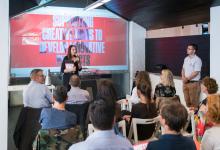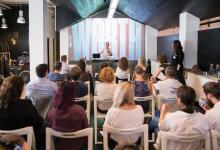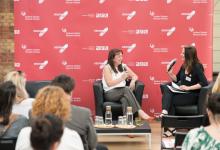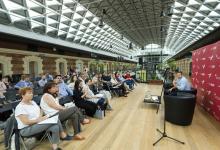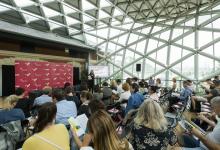Design and health
This year, the World Industrial Design Day focused on the link between design, physical health and well-being. Organised jointly by the Hungarian Design Council and Budapest Design Week, the domestic design scene celebrated the World Industrial Design Day on 28 June in Bálna Cultural Commercial and Leisure Centre in Budapest, presenting the most exciting domestic health design projects. Moreover, the event concurrently served as an preparatory programme to Budapest Design Week, which is to be held in the autumn welcoming Germany as a guest.
This year, the World Industrial Design Day focused on Sustainable Development Goal No. 3 adopted by the United Nations, i.e. the topic of health. Celebrated by World Design Organization (WDO) on 29 June every year, the event was organised in Hungary by the Hungarian Design Council and Budapest Design Week. The event concentrated on business development; the programme of this year’s World Industrial Design Day ranged from international projects through exhibition opportunities to various publications helping design businesses, advice on venture capital and networking events.
One of the projects presented was Worth Partnership Project, which had a Hungarian mentor and whose representatives were invited by the Hungarian Design Council to present the project opportunities and the terms of tendering in the form of a workshop and a presentation. In his presentation, project coordinator Zicri A. Montiel explained that Worth Partnership Project also seeks to promote cooperation among creative industry experts, technological companies and makers committed to innovative experimenting with and developing materials. Worth mentor and President of the Cultural Creative Industry Cluster Keresnyei János and Worth Ambassador Gabriella Mányi spoke about the initiative funded by the European Union’s COSME programme and about the tendering opportunities. János Keresnyei pointed out the project objective: to foster international relationships between designers and manufacturers by supporting viable initiatives arising out of real problems, and support their implementation also through financing. As Mr Keresnyei said, the registration deadline is 24 October, but it is worth registering as soon as possible because registration opens up an opportunity to find international partners and to compile joint tenders.
Linked to the World Industrial Design Day, a joint project of Pure Design, Hungexpo Zrt. and Budapest Design Week was presented; its next move will be held between 12 and 14 October at the HOMEDesign exhibition and fair. As Sales Director of Construma Zrt. Krisztina Szilvási said, the initiative launched in cooperation with Budapest Design Week aims to provide an affordable but fully competitive and high-standard exhibition opportunity for small and medium-sized enterprises operating in the field of design. Curator of Budapest Design Week Judit Osvárt added that cooperation does not only offer to coordinate stands but also organises a joint conference and other fringe programmes.
Flying Objects designer András Húnfalvi presented a stethoscope called Dualscope that had previously won an iF Design Award. Requested by Prof. Dr. György Kozmann, who has decades of experience in body surface potential mapping, and by his team, Húnfalvi and his coworkers, Ferenc Laufer and Luca Patkós designed a new-generation stethoscope that is capable of concurrently analysing electrocardiography (ECG) and phonocardiogram (PCG), in addition to transmitting the results by Bluetooth to an application opened on a tablet or a smartphone.
Péter L. Molnár presented the Aquila blood analysis device designed by Maform Design Studio (Tamás Fejér, Apor Kovács, Róbert Kovács, Péter L. Molnár) in a lecture, in which he explained how the device adapts to the trends of medical electronics through its compact design and minimalism.
Enterprise development was assigned a key role on the World Industrial Design Day. Economist and venture capital specialist of the Hungarian Intellectual Property Agency Ádám Németh gave a presentation entitled “Diagnosis” on how young businesses can become suitable to receive investments, how they can secure a capital injection, and how they can find a manufacturer in the framework of an international project.
After his presentation, Ádám Németh received interested members of the audience for a personal consultation.
At the event, a publication by the Hungarian Design Council and Budapest Design Week each was presented. The Hungarian Design Council issued Start Up Guide 13.0 to provide up-to-date assistance to small and medium-sized enterprises – from writing a business plan to the latest design thinking and lean methodologies. The publication is free to download also this year from the Hungarian Design Council’s website at kreativipar.startupguide.hu.
Budapest Design Week presented the updated version of its popular design map, Budapest Design Map. As curator Judit Osvárt said, the publication includes 150 Budapest-based design enterprises, reflecting a true view of the diversity seen in the Hungarian design world. Budapest Design Map is now available in a printed format at roughly 200 locations in addition to the event, while an electronic version is accessible on Google Maps.
After the event, curators Szilvia Szigeti and Tamás Radnóti gave a guided tour of Design without Borders – 13. Madeinhungary and 06. MeeD exhibitions in the Budapest Gallery. The World Industrial Design Day concluded with informal networking and a DJ set show in Hygge on the ground floor of Bálna Cultural Commercial and Leisure Centre.
Presentations of the World Industrial Design Day event and further information on the WORTH project:
WORTH - Value Innovation By János Keresnyei
WORTH - Sustainable Fashion By Gabriella Mányi





